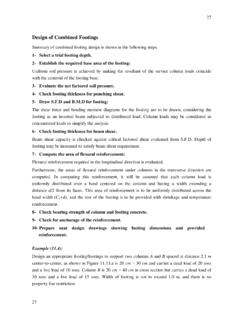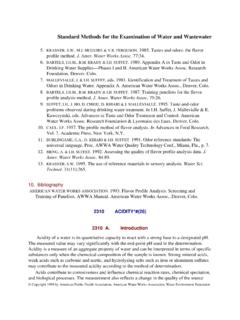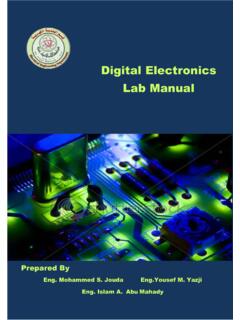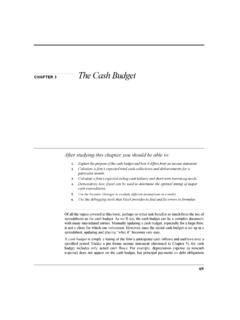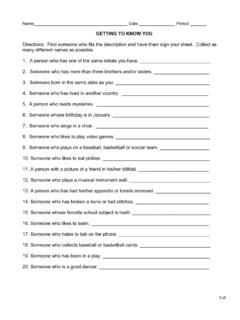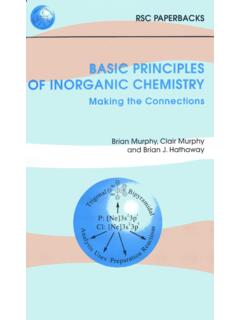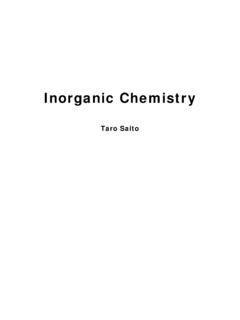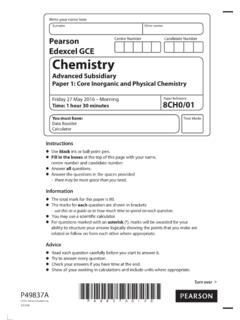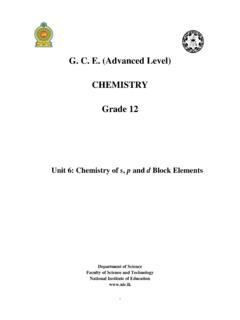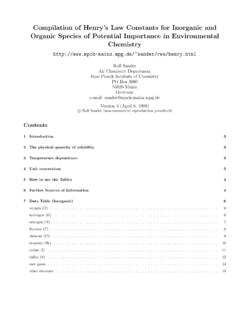Transcription of Inorganic Chemistry, Second Edition
1 Instant Notes Inorganic chemistry Second Edition The INSTANT NOTES series Series Editor: School of Biochemistry and Molecular Biology, University of Leeds, Leeds, UK. Animal Biology 2nd Edition Biochemistry 2nd Edition Bioinformatics chemistry for Biologists 2nd Edition Developmental Biology Ecology 2nd Edition Immunology 2nd Edition Genetics 2nd Edition Microbiology 2nd Edition Molecular Biology 2nd Edition Neuroscience Plant Biology chemistry series Consulting Editor: Howard Stanbury Analytical chemistry Inorganic chemistry 2nd Edition Medicinal chemistry Organic chemistry 2nd Edition Physical chemistry Psychology series Sub-series Editor: Hugh Wagner Dept of Psychology, University of Central Lancashire, Preston, UK.
2 Psychology Forthcoming titles Cognitive Psychology Physiological Psychology Instant Notes Inorganic chemistry Second Edition Inorganic chemistry Laboratory, New College, Oxford, UK. LONDON AND NEW YORK. Garland Science/BIOS Scientific Publishers, 2004. First published 2000. Second Edition 2004. All rights reserved. No part of this book may be reproduced or transmitted, in any form or by any means, without permission. A CIP catalogue record for this book is available from the British Library. ISBN 0-203-48827-X Master e-book ISBN. ISBN 0-203-59760-5 (Adobe eReader Format). ISBN 1 85996 289 0. Garland Science/BIOS Scientific Publishers 4 Park Square, Milton Park, Abingdon, Oxon OX14 4RN, UK and 29 West 35th Street, New York, NY 10001 2299, USA.
3 World Wide Web home page: Garland Science/BIOS Scientific Publishers is a member of the Taylor & Francis Group This Edition published in the Taylor & Francis e-Library, 2005. To purchase your own copy of this or any of Taylor & Francis or Routledge's collection of thousands of eBooks please go to . Distributed in the USA by Fulfilment Center Taylor & Francis 10650 Toebben Drive Independence, KY 41051, USA. Toll Free Tel.: +1 800 634 7064; E-mail: Distributed in Canada by Taylor & Francis 74 Rolark Drive Scarborough, Ontario M1R 4G2, Canada Toll Free Tel: +1 877 226 2237; E-mail: Distributed in the rest of the world by Thomson Publishing Services Cheriton House North Way Andover, Hampshire SP10 5BE, UK.
4 Tel: +44 (0)1264 332424; E-mail: Library of Congress Cataloging-in-Publication Data Cox, Inorganic 2nd ed. p. cm. (The instant notes chemistry series). Includes bibliographical references and index. ISBN 1-85996-289-0 (pbk.). 1. chemistry , Inorganic Outlines, syllabi, etc. I. Title. II. Series. 2004 546 .02 02 dc22. Production Editor: Andrea Bosher CONTENTS. Abbreviations viii Preface x Section A Atomic structure A1 The nuclear atom 2. A2 Atomic orbitals 6. A3 Many-electron atoms 11. A4 The periodic table 15. A5 Trends in atomic properties 19. Section B Introduction to Inorganic substances B1 Electronegativity and bond type 25.
5 B2 Chemical periodicity 29. B3 Stability and reactivity 33. B4 Oxidation and reduction 37. B5 Describing Inorganic compounds 41. B6 Inorganic reactions and synthesis 45. B7 Methods of characterization 49. Section C Structure and bonding in molecules C1 Electron pair bonds 55. C2 Molecular shapes: VSEPR 60. C3 Molecular symmetry and point groups 65. C4 Molecular orbitals: homonuclear diatomics 70. C5 Molecular orbitals: heteronuclear diatomics 75. C6 Molecular orbitals: polyatomics 79. C7 Rings and clusters 83. C8 Bond strengths 87. vi C9 Lewis acids and bases 91. C10 Molecules in condensed phases 94. Section D Structure and bonding in solids D1 Introduction to solids 98.
6 D2 Element structures 102. D3 Binary compounds: simple structures 106. D4 Binary compounds: factors influencing structure 111. D5 More complex solids 115. D6 Lattice energies 119. D7 Electrical and optical properties of solids 124. Section E chemistry in solution E1 Solvent types and properties 129. E2 Br nsted acids and bases 133. E3 Complex formation 137. E4 Solubility of ionic substances 141. E5 Electrode potentials 144. Section F chemistry of nonmetals F1 Introduction to nonmetals 149. F2 Hydrogen 152. F3 Boron 156. F4 Carbon, silicon and germanium 160. F5 Nitrogen 164. F6 Phosphorus, arsenic and antimony 168. F7 Oxygen 172.
7 F8 Sulfur, selenium and tellurium 176. F9 Halogens 180. F10 Noble gases 184. Section G chemistry of non-transition metals G1 Introduction to non-transition metals 188. G2 Group 1: alkali metals 192. G3 Group 2: alkaline earths 195. G4 Group 12: zinc, cadmium and mercury 198. vii G5 Group 13: aluminum to thallium 201. G6 Group 14: tin and lead 205. Section H chemistry of transition metals H1 Introduction to transition metals 209. H2 Ligand field theory 213. H3 3d series: aqueous ions 217. H4 3d series: solid compounds 220. H5 4d and 5d series 223. H6 Complexes: structure and isomerism 226. H7 Complexes: kinetics and mechanism 230.
8 H8 Complexes: electronic spectra and magnetism 233. H9 Complexes: acceptor ligands 237. H10 Organometallic compounds 241. Section I Lanthanides and actinides I1 Lanthanum and the lanthanides 247. I2 Actinium and the actinides 250. Section J Environmental, biological and industrial aspects J1 Origin and abundance of the elements 254. J2 Geochemistry 257. J3 Bioinorganic chemistry 260. J4 Industrial chemistry : bulk Inorganic chemicals 265. J5 Industrial chemistry : catalysts 269. J6 Environmental cycling and pollution 273. Further reading 277. Appendix I The elements 1 103 279. Appendix II The Periodic Table of Elements 280.
9 Index 281. ABBREVIATIONS. 3c2e three-center two-electron 3c4e three-center four-electron 3D three dimensional ADP adenosine diphosphate An actinide AO atomic orbital ATP adenosine triphosphate bcc body-centered cubic BO bond order BP boiling point CB conduction band ccp cubic close packing CN coordination number Cp cyclopentadienyl (C5H5). E unspecified (non-metallic) element EA electron affinity EAN effective atomic number EDTA ethylenediamine tetraacetate Et ethyl (C2H5). fcc face-centered cubic hcp hexagonal close packing HOMO highest occupied molecular orbital HSAB hard and soft acid-base IE (first) ionization energy In nth ionization energy (n=1, 2, ).
10 IUPAC International Union of Pure and Applied chemistry L unspecified ligand LCAO linear combination of atomic orbitals LFSE ligand field stabilization energy LMCT ligand-to-metal charge transfer LUMO lowest unoccupied molecular orbital ix Ln lanthanide M unspecified (metallic) element Me methyl (CH3). MLCT metal-to-ligand charge transfer MO molecular orbital MP melting point Ph phenyl (C6H5). R organic group (alkyl or aryl). RAM relative atomic mass SN steric number UV ultraviolet VB valence band VE valence electron VSEPR valence shell electron pair repulsion X unspecified element (often a halogen). Z atomic number PREFACE.
